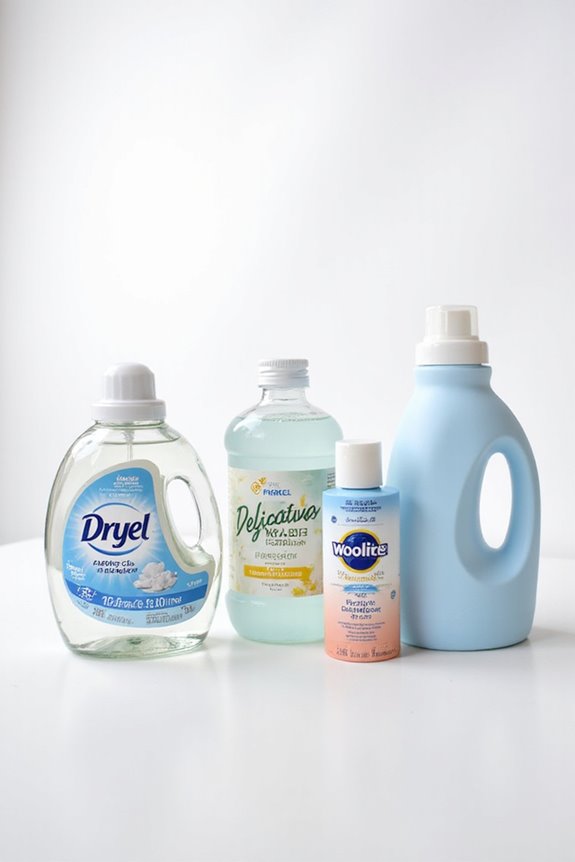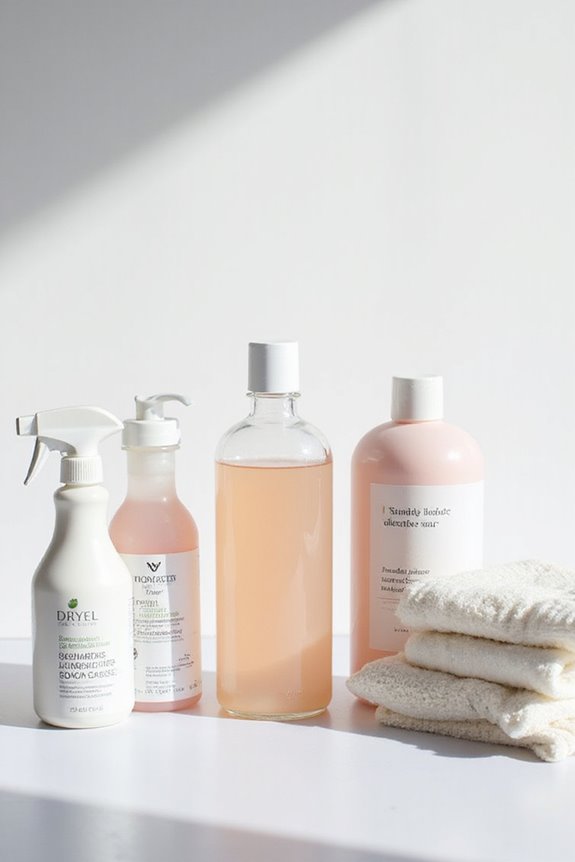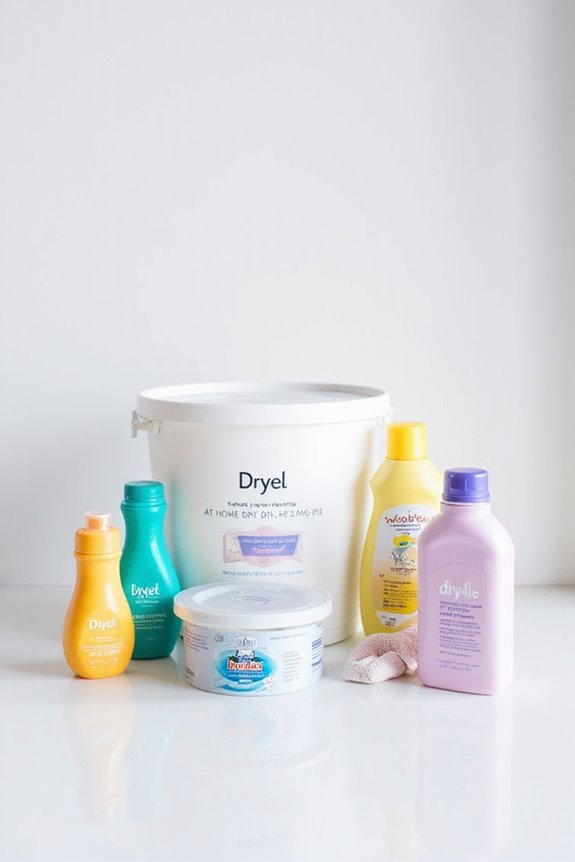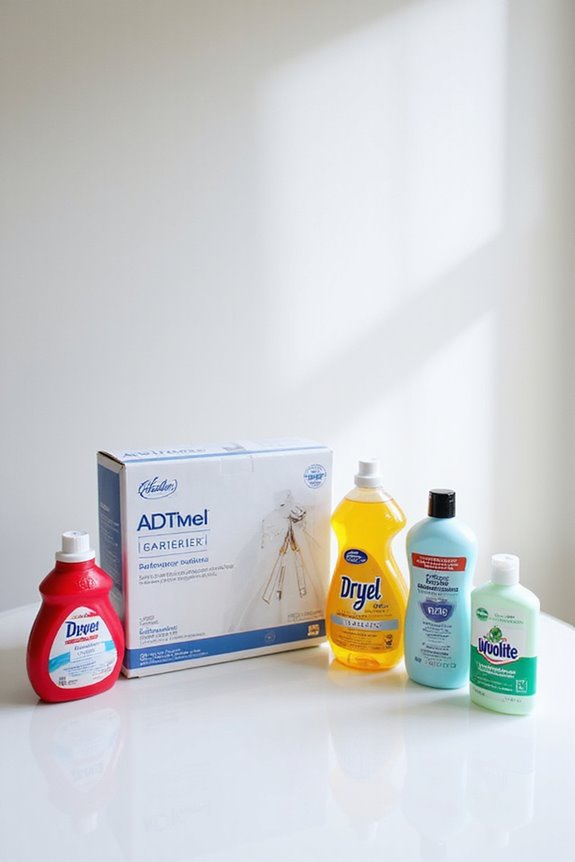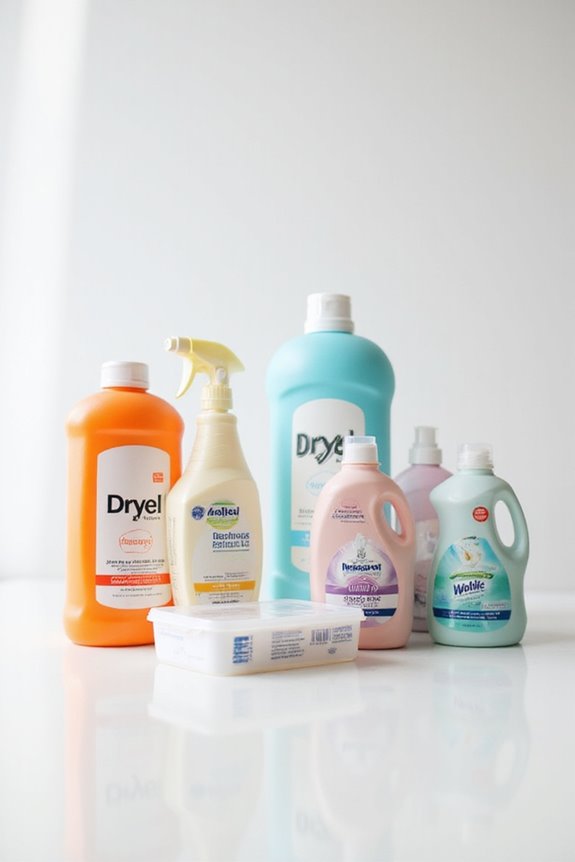If we find ourselves with stubborn dry-cleaning odors, we can tackle them using a few handy tricks. First, let’s try baking soda. It’s great for absorbing those pesky smells. We can sprinkle it on our clothes and let it sit. Vinegar steam treatment works wonders, too—just hang garments above steaming water mixed with vinegar. Or, we could wash them with vinegar or borax for extra stubborn odors. Curious for more tips? There’s plenty left to explore!
Key Takeaways
- Sprinkle baking soda on the garment and let it sit to absorb lingering odors before brushing it off.
- Use a vinegar steam treatment by hanging the item above steaming water mixed with vinegar to neutralize smells.
- Wash the item with vinegar or borax to break down and eliminate stubborn odors effectively.
- Place coffee grounds in breathable sachets with the garment to mask unwanted odors with a pleasant aroma.
- Ensure proper ventilation in your laundry area while regularly cleaning your washing machine to prevent odor buildup.
Baking Soda for Odor Absorption
When it comes to tackling stubborn odors after dry cleaning, we might want to contemplate using baking soda, since it’s an easy and effective solution. The baking soda benefits are impressive; it absorbs odors instead of just covering them up. We can sprinkle it generously on our garments, paying special attention to seams and hidden spots. For those stubborn smells, enclosing our items in a sealed bag with a baking soda-filled sock can work wonders over a few days. Plus, it’s eco-friendly and doesn’t harm our fabrics. If we create a paste for spot treatments, we can tackle lingering odors directly. So, let’s embrace these deodorizing techniques and give our clothes a fresh start!
Vinegar Steam Treatment

After we’ve tackled odors with baking soda, let’s explore another effective method: the vinegar steam treatment. Vinegar’s properties, specifically its acetic acid, can kill bacteria that cause odors. By using steam, we open up fabric fibers, allowing those vinegar vapors to penetrate deeply.
Here’s how we do it: fill a bathtub with hot water and add a good amount of white vinegar. Then, hang our dry cleaning garments above the steaming water. This lets the steam work its magic for a few hours. We’ve found it’s great for neutralizing sweat and dry cleaning solvent smells, but not so much for heavy grease. Plus, it’s safe for most fabrics, making it a win-win for odor removal! Additionally, using a hypoallergenic formula can further ensure that any residual odors don’t irritate sensitive skin.
Washing With Vinegar or Borax
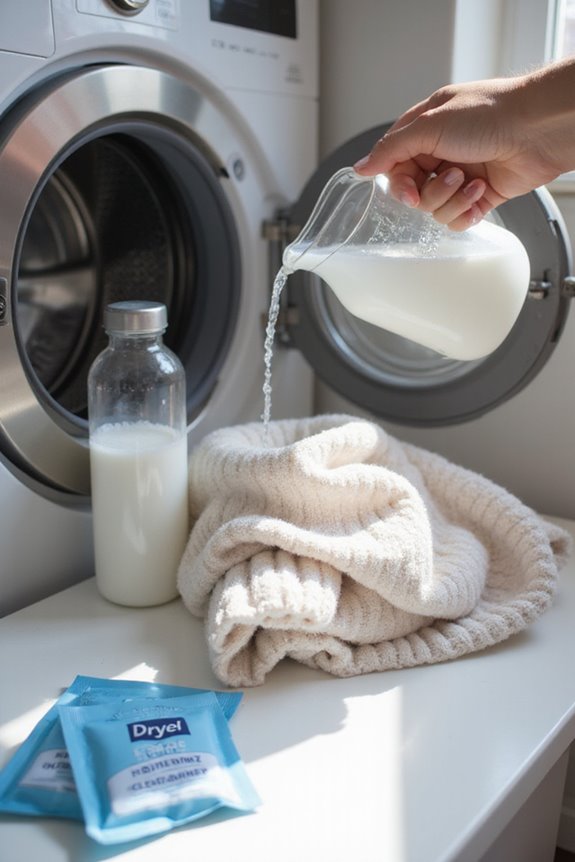
If we want to tackle stubborn odors in our laundry, using vinegar or borax can be a game changer. Vinegar’s acidity helps break down odors, but let’s not forget the borax benefits! Borax neutralizes smells by changing the pH of water, which means it can take on musty towels and smelly sportswear like a champ.
When we add borax to our wash, it boosts detergent performance and even brightens whites. In a vinegar comparison, borax shines in hard water areas, softening it and enhancing cleaning power. For extra stubborn odors, we can pre-soak items with borax for half an hour. Trust us, giving our laundry a boost with these two is worth a try! Additionally, consider using antibacterial detergents that effectively combat odors and bacteria for an even fresher outcome.
Use of Coffee Grounds

Coffee grounds can be a surprisingly effective tool in our fight against unwanted odors, especially after dry cleaning. They contain nitrogen, which helps with odor neutralization by reacting with pesky sulfur gases. Plus, their porous structure absorbs and traps bad smells like a pro. We can simply place fresh or dried coffee grounds in breathable sachets and store them with our dry-cleaned clothes.
Not only do they mask unwanted odors with their pleasant aroma, but they also keep our closets smelling fresh. If we use them regularly, we should replace the grounds every couple of weeks. So, let’s give coffee grounds a shot—our clothes (and noses) will thank us!
Post-Dry Cleaning Ventilation and Freshening
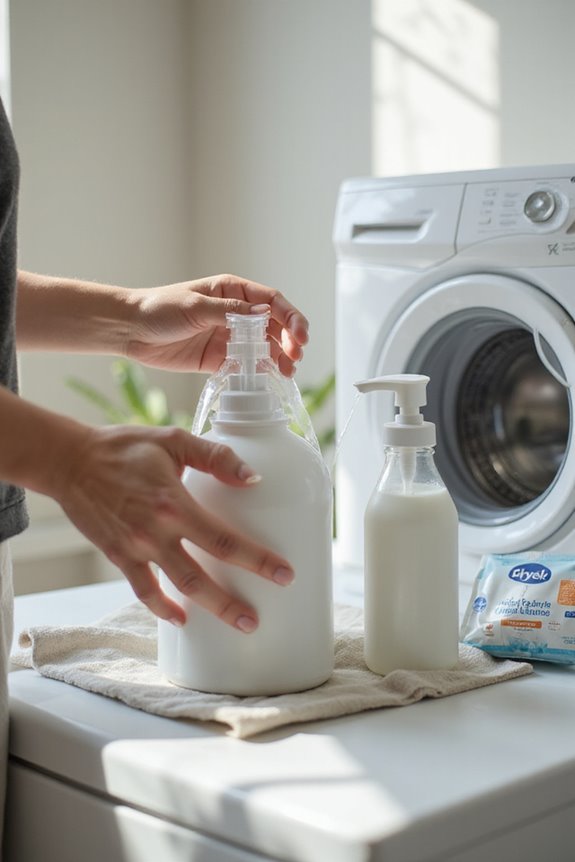
We all know that dry cleaning can leave our clothes looking sharp, but sometimes it also leaves behind a lingering smell that’s less than pleasant. To tackle this, we should use effective ventilation techniques right at home. Opening windows and doors immediately after cleaning helps with air circulation, letting fresh air in and stale odors out. We can also position portable fans to boost air movement towards those open spaces.
Let’s avoid sealing our cleaned garments in airtight containers right away, as that can trap those pesky solvent vapors. Instead, letting our clothes “air out” in a well-ventilated area for a few hours can work wonders. It’s a simple way to freshen up and enjoy our freshly cleaned wardrobe!
Advanced and Alternative Treatments
When it comes to tackling stubborn odors after dry cleaning, we’ve got some advanced and alternative treatments that can really save the day. For instance, enzyme cleaners are fantastic for breaking down organic odor sources like sweat and body oils. Just apply them to smelly spots, let them work for 10–30 minutes, and then launder as usual.
We can also use activated charcoal. It absorbs those pesky odor molecules, leaving no scent behind. Just sprinkle it on, let it sit overnight, and vacuum it off.
For a fun twist, try sealing your garment with charcoal or baking soda in a bag for 24–48 hours. Trust us, these methods can make a world of difference in freshening up your clothes! Additionally, baking soda is well-known for its deodorizing properties that effectively neutralize odors in various surfaces, making it a versatile option for freshening up fabrics.
Regular Maintenance Tips
Taking care of our clothes after dry cleaning can make a big difference in how they smell and last. First, let’s remember to do some routine airing. After we pick up our dry cleaning, hanging our clothes in a well-ventilated area helps release those pesky chemical odors. Sunlight is a bonus!
Next, we can use fabric sprays that contain odor neutralizers. These sprays don’t just mask smells; they break them down, ensuring our favorite outfits stay fresh. For optimal freshness, consider using products like Febreze Odor-Fighting Fabric Refresher, which effectively neutralizes tough odors.
Also, don’t forget about good storage! Using breathable garment bags and moisture absorbers can prevent musty odors. We’ve all experienced that dreaded smell, so let’s keep our clothes smelling great with these easy tips. Happy airing!
Professional Assistance Options
If you find yourself battling stubborn odors that just won’t budge, it might be time to call in the pros. Professional odor detection uses specialized equipment to find the source of those pesky smells. Whether it’s pet odors or smoke, trained technicians know how to tackle the problem effectively. They often employ enzymatic treatments that break down organic molecules at the source, ensuring we’re not just masking the smell. Plus, with advanced techniques like air purification and oxidation processes, they can neutralize even the most complex odors. It’s reassuring to have experts handle this, reducing the risk of fabric damage while providing tailored solutions. Additionally, many professionals recommend using specialized washing machine cleaners to maintain freshness and prevent future odors in laundry appliances. So, let’s leave the heavy lifting to them and breathe easy again!
Testing Methods for Delicate Fabrics
Testing delicate fabrics for odors can feel like maneuvering through a minefield, especially when we’re trying to keep our favorite garments intact. First, we should identify the fabric type—silk, wool, or rayon—and check care labels for fabric care recommendations. In our test preparation, we can perform a small patch test in an inconspicuous area. We want to use gentle agents like diluted white vinegar or baking soda. After applying the agent, we let it dry, watching for any color change. If all goes well, we can try placing baking soda in a sock with the garment in a sealed bag for odor absorption. Remember, patience is key, and testing helps protect our beloved clothes! Additionally, using hypoallergenic detergents can further minimize the risk of irritation when cleaning delicate fabrics.
Frequently Asked Questions
Can I Use Essential Oils to Mask Dry Cleaning Odors?
Imagine strolling through a fragrant garden; we can use essential oil types like lavender or lemon to mask dry cleaning odors. Their scent longevity can transform our garments, but remember, they’re just a delightful disguise!
How Long Should I Leave Baking Soda in the Garment Bag?
We should leave baking soda in the garment bag for about five days to maximize its effectiveness. This duration allows it to thoroughly absorb odors, ensuring our clothes smell fresh and clean once we take them out.
Will Washing With Vinegar Damage My Clothes?
We might think vinegar’s just for salads, but it can actually offer benefits for fabrics! While it’s generally safe, we should always check fabric compatibility to avoid any unintended surprises, like color bleeding or damage.
Can I Combine Coffee Grounds With Other Odor Removal Methods?
Absolutely, we can combine coffee grounds with other methods for better odor absorption. Mixing them with baking soda or essential oils enhances their effectiveness, creating a powerful, natural solution for tackling unpleasant smells in our spaces.
How Do I Know if My Fabric Is Safe for Vinegar Treatment?
Did you know that 30% of fabric damage comes from improper care? We should always check our fabric care labels for vinegar safety, especially if we’re dealing with persistent odor sources or delicate materials.

